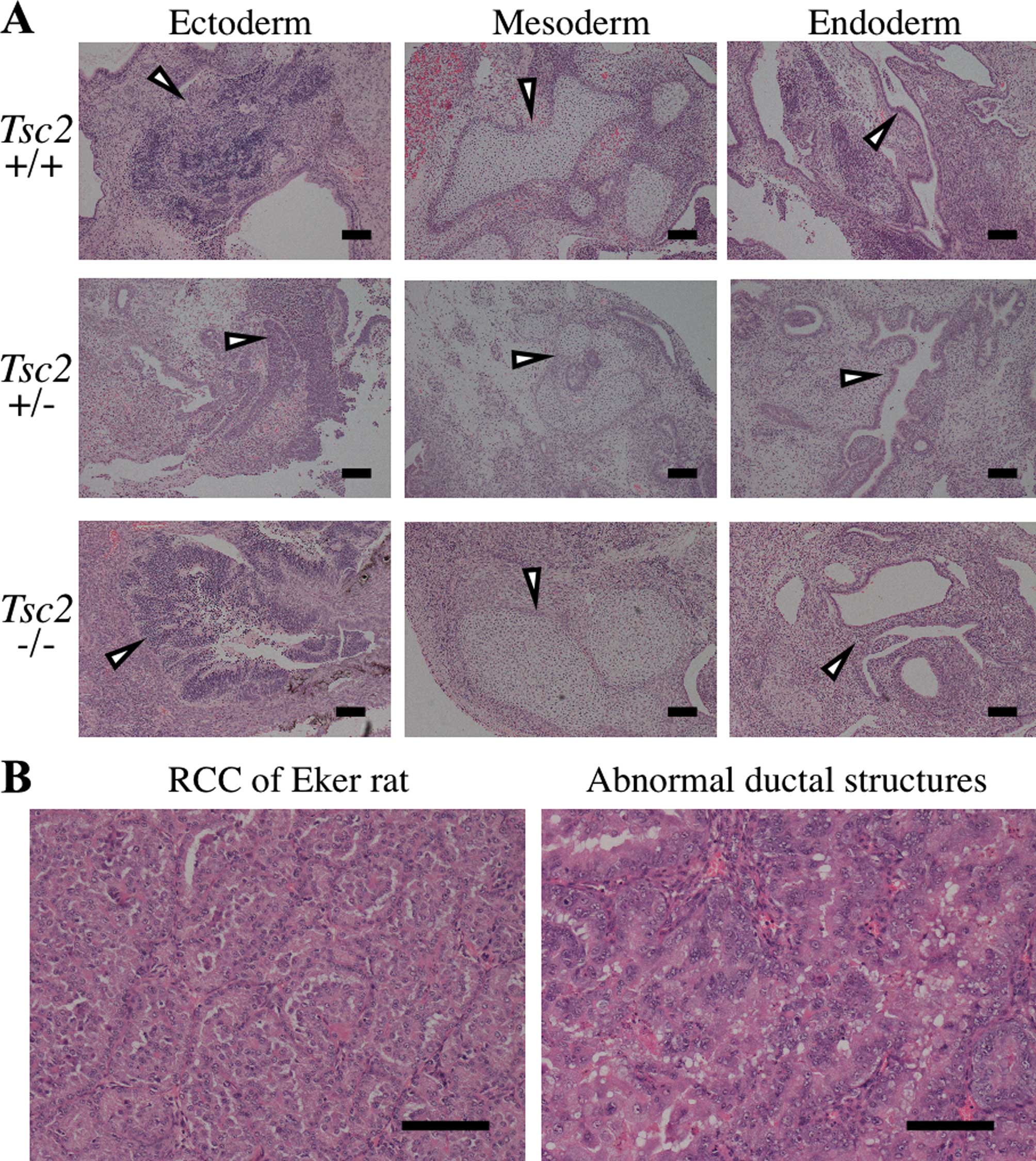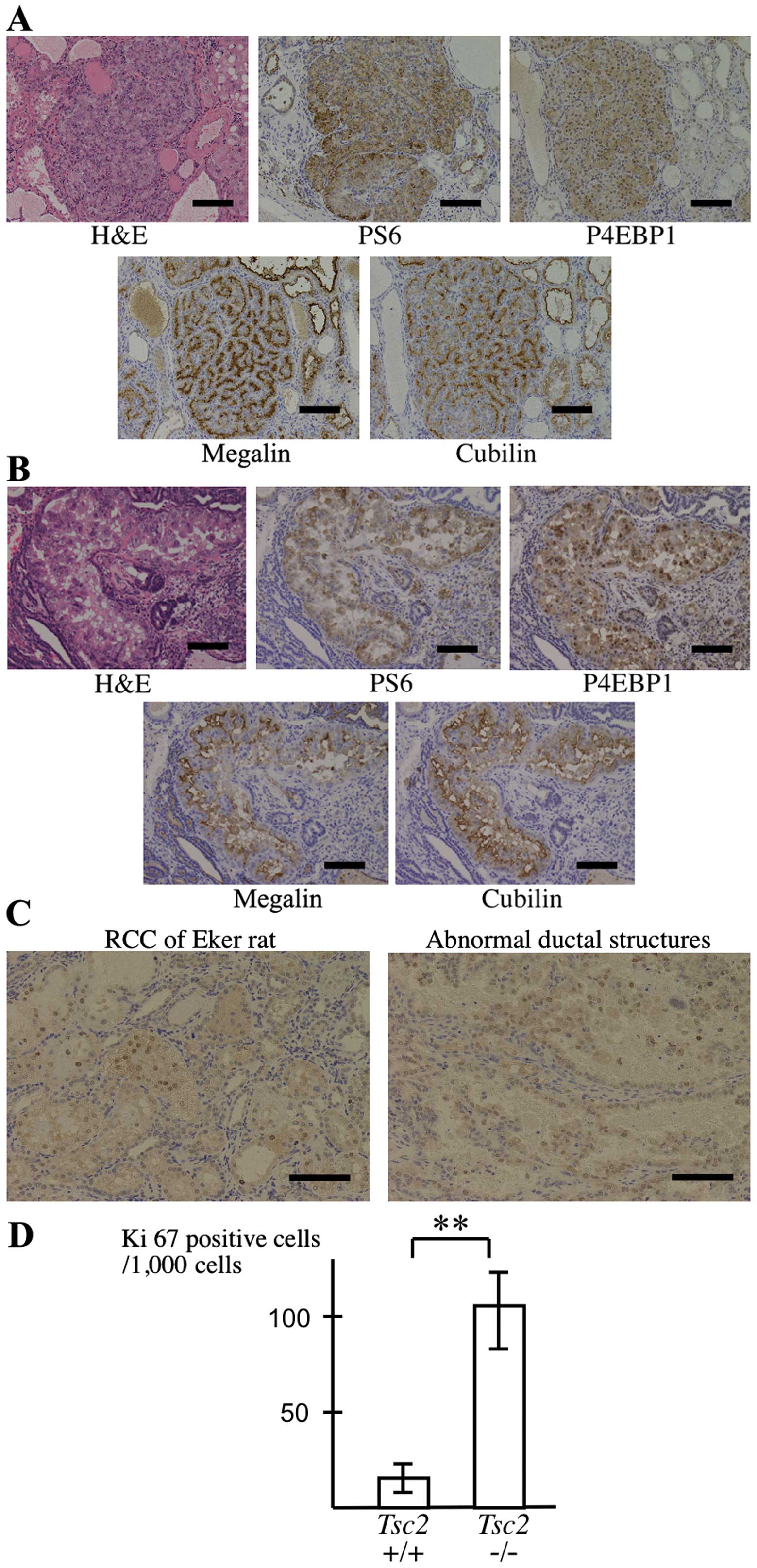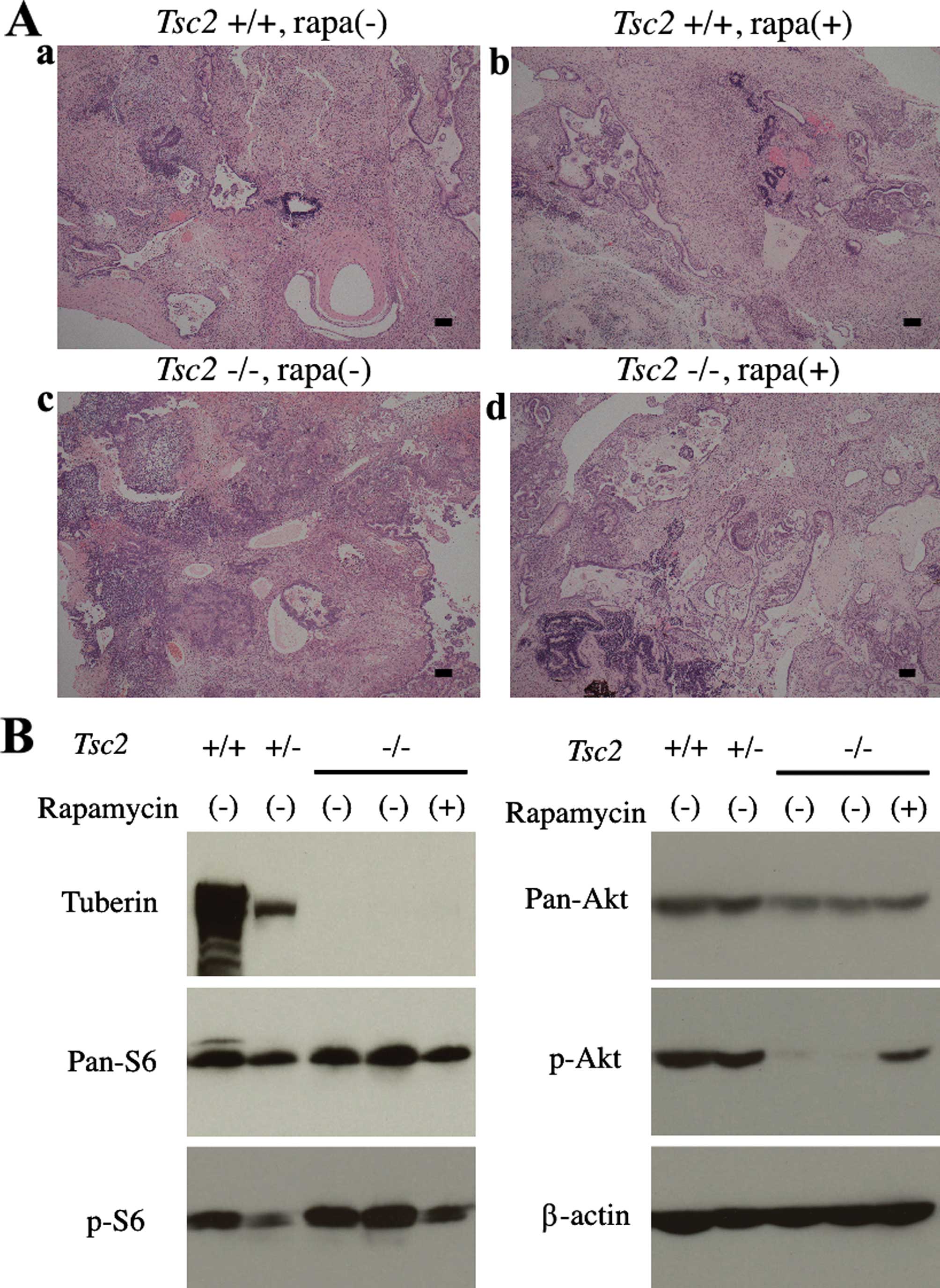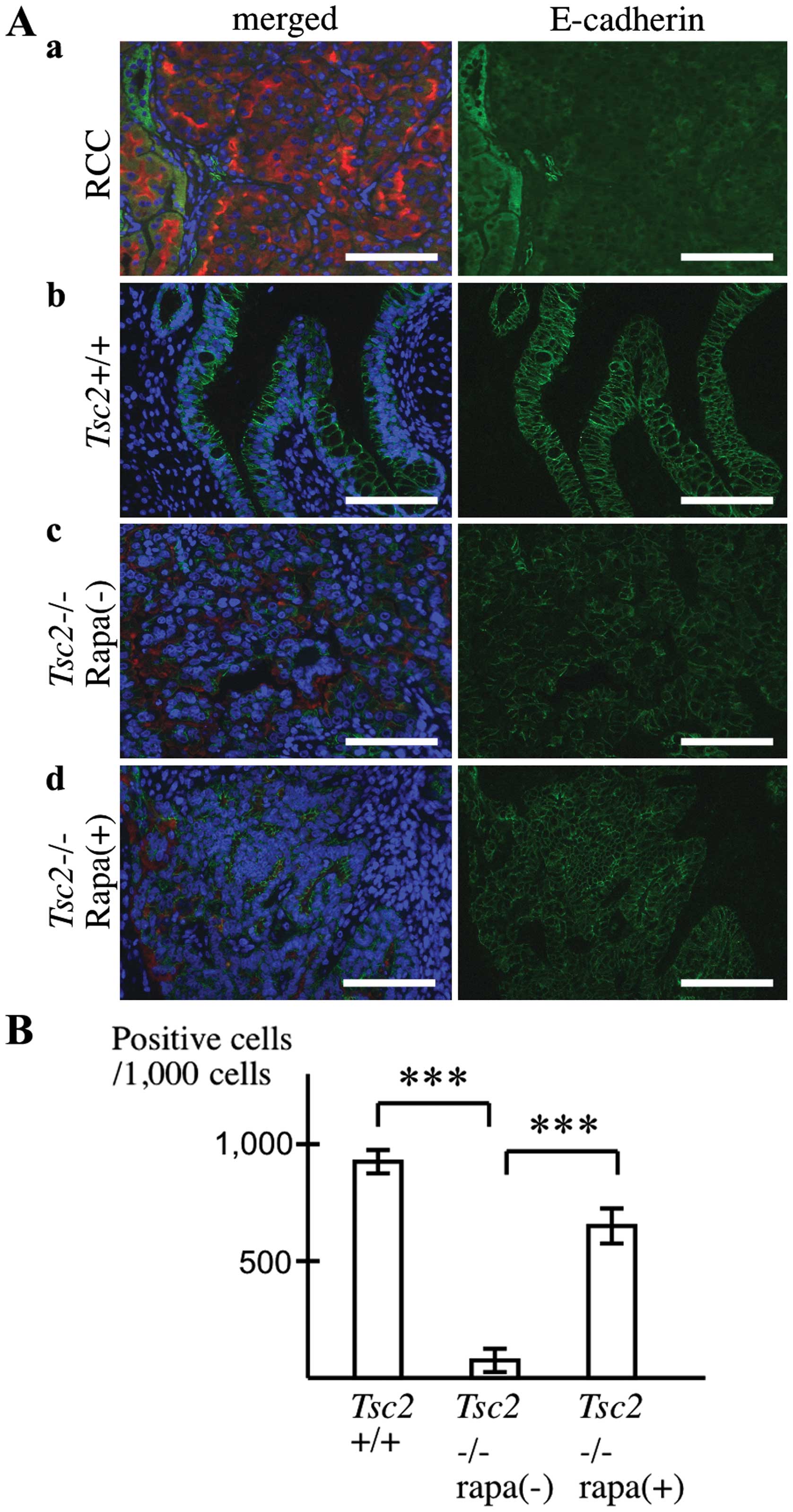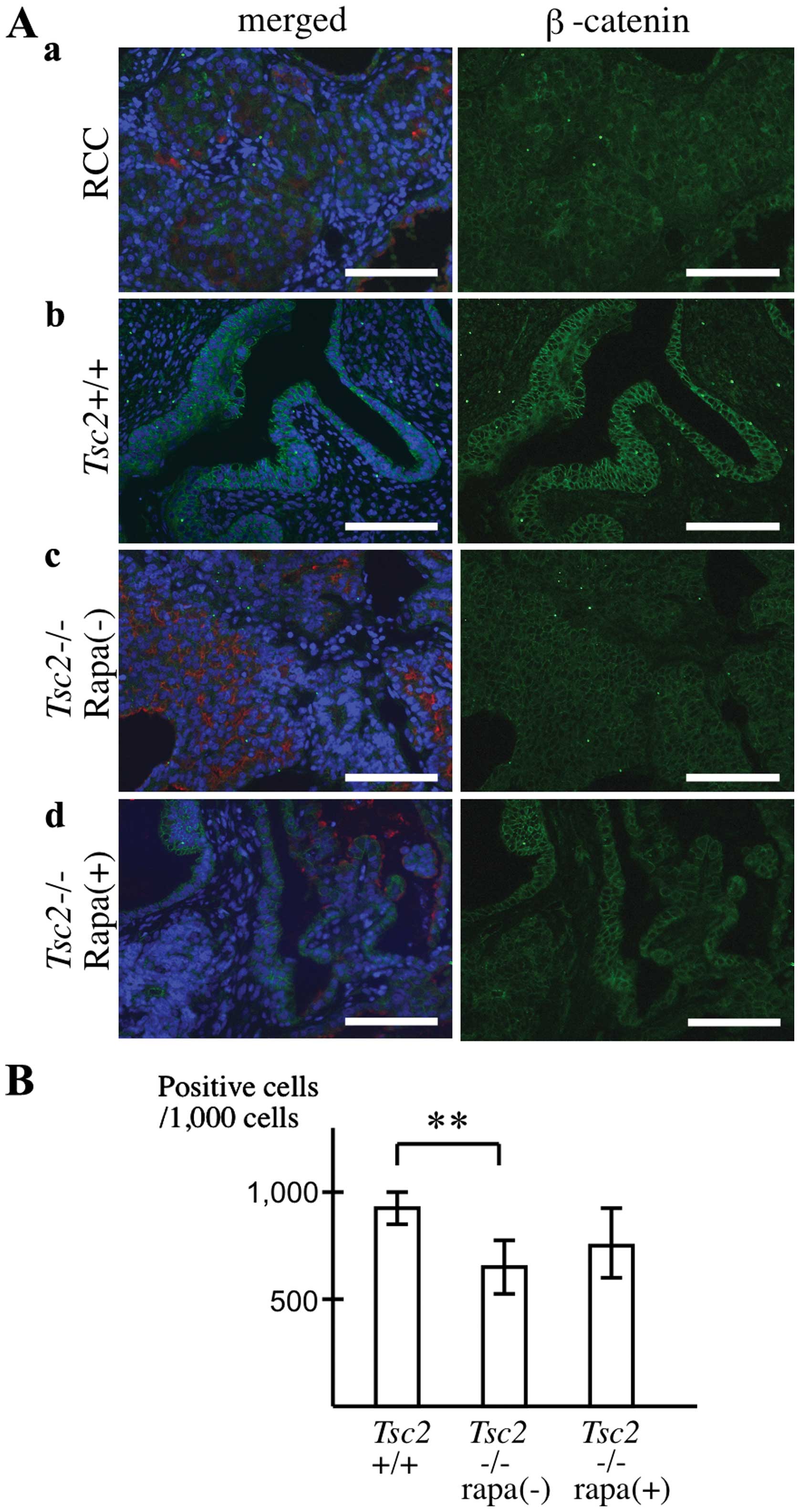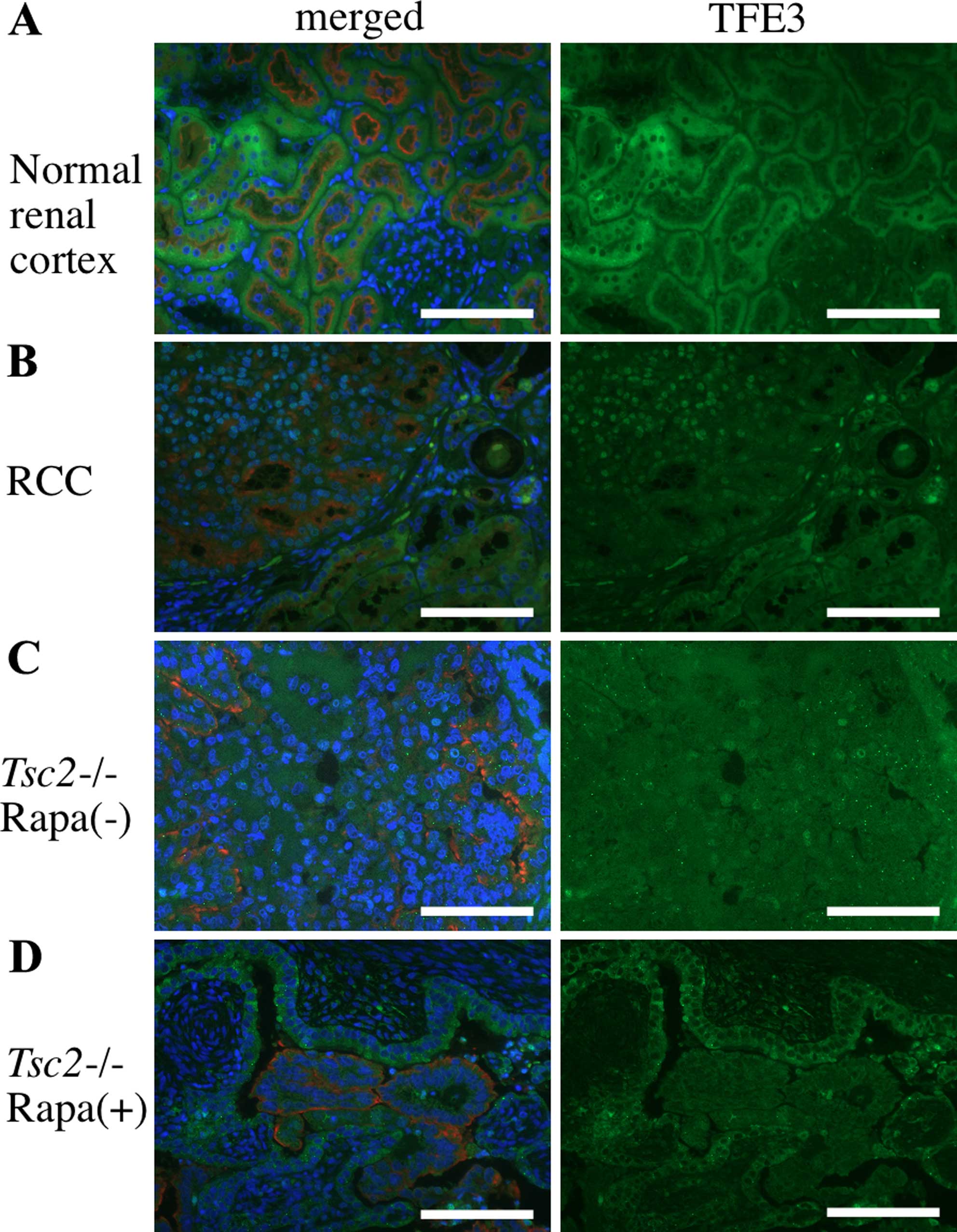|
1
|
Eker E and Mossige J: A Dominant gene for
renal adenomas in the rat. Nature. 189:858–859. 1961. View Article : Google Scholar
|
|
2
|
Kobayashi T, Hirayama Y, Kobayashi E, Kubo
Y and Hino O: A germline insertion in the tuberous sclerosis (Tsc2)
gene gives rise to the Eker rat model of dominantly inherited
cancer. Nat Genet. 9:70–74. 1995. View Article : Google Scholar : PubMed/NCBI
|
|
3
|
Yeung RS, Xiao GH, Jin F, Lee WC, Testa JR
and Knudson AG: Predisposition to renal carcinoma in the Eker rat
is determined by germ-line mutation of the tuberous sclerosis 2
(TSC2) gene. Proc Natl Acad Sci USA. 91:11413–11416. 1994.
View Article : Google Scholar : PubMed/NCBI
|
|
4
|
Rennebeck G, Kleymenova EV, Anderson R,
Yeung RS, Artzt K and Walker CL: Loss of function of the tuberous
sclerosis 2 tumor suppressor gene results in embryonic lethality
characterized by disrupted neuroepithelial growth and development.
Proc Natl Acad Sci USA. 95:15629–15634. 1998. View Article : Google Scholar : PubMed/NCBI
|
|
5
|
Everitt JI, Goldsworthy TL, Wolf DC and
Walker CL: Hereditary renal cell carcinoma in the Eker rat: A
rodent familial cancer syndrome. J Urol. 148:1932–1936.
1992.PubMed/NCBI
|
|
6
|
Hino O, Klein-Szanto AJ, Freed JJ, Testa
JR, Brown DQ, Vilensky M, Yeung RS, Hino O, Klein-Szanto AJ, Freed
JJ, Testa JR, Brown DQ, Vilensky M, Yeung RS, Tartof KD and Knudson
AG: Spontaneous and radiation-induced renal tumors in the Eker rat
model of dominantly inherited cancer. Proc Natl Acad Sci USA.
90:327–331. 1993. View Article : Google Scholar : PubMed/NCBI
|
|
7
|
Kandt RS, Haines JL, Smith M, Northrup H,
Gardner RJ, Short MP, Dumars K, Kandt RS, Haines JL, Smith M, et
al: Linkage of an important gene locus for tuberous sclerosis to a
chromosome 16 marker for polycystic kidney disease. Nat Genet.
2:37–41. 1992. View Article : Google Scholar : PubMed/NCBI
|
|
8
|
European Chromosome 16 Tuberous Sclerosis
Consortium: Identification and characterization of the tuberous
sclerosis gene on chromosome 16. Cell. 75:1305–1315. 1993.
View Article : Google Scholar : PubMed/NCBI
|
|
9
|
van Slegtenhorst M, de Hoogt R, Hermans C,
Nellist M, Janssen B, Verhoef S, Lindhout D, van den Ouweland A,
Halley D, Young J, et al: Identification of the tuberous sclerosis
gene TSC1 on chromosome 9q34. Science. 277:805–808. 1997.
View Article : Google Scholar : PubMed/NCBI
|
|
10
|
Orlova KA and Crino PB: The tuberous
sclerosis complex. Ann NY Acad Sci. 1184:87–105. 2010. View Article : Google Scholar : PubMed/NCBI
|
|
11
|
Kim DH, Sarbassov DD, Ali SM, King JE,
Latek RR, Erdjument-Bromage H, Tempst P and Sabatini DM: mTOR
interacts with raptor to form a nutrient-sensitive complex that
signals to the cell growth machinery. Cell. 110:163–175. 2002.
View Article : Google Scholar : PubMed/NCBI
|
|
12
|
Kenerson HL, Aicher LD, True LD and Yeung
RS: Activated mammalian target of rapamycin pathway in the
pathogenesis of tuberous sclerosis complex renal tumors. Cancer
Res. 62:5645–5650. 2002.PubMed/NCBI
|
|
13
|
Sarbassov DD, Ali SM, Kim DH, Guertin DA,
Latek RR, Erdjument-Bromage H, Tempst P and Sabatini DM: Rictor, a
novel binding partner of mTOR, defines a rapamycin-insensitive and
raptor-independent pathway that regulates the cytoskeleton. Curr
Biol. 14:1296–1302. 2004. View Article : Google Scholar : PubMed/NCBI
|
|
14
|
Kielman MF, Rindapää M, Gaspar C, van
Poppel N, Breukel C, van Leeuwen S, Taketo MM, Roberts S, Smits R
and Fodde R: Apc modulates embryonic stem-cell differentiation by
controlling the dosage of beta-catenin signaling. Nat Genet.
32:594–605. 2002. View
Article : Google Scholar : PubMed/NCBI
|
|
15
|
Ito Y, Kawano H, Kanai F, Nakamura E, Tada
N, Takai S, Horie S, Arai H, Kobayashi T and Hino O: Establishment
of Tsc2-deficient rat embryonic stem cells. Int J Oncol.
46:1944–1952. 2015.PubMed/NCBI
|
|
16
|
McDorman KS and Wolf DC: Use of the
spontaneous Tsc2 knockout (Eker) rat model of hereditary renal cell
carcinoma for the study of renal carcinogens. Toxicol Pathol.
30:675–680. 2002. View Article : Google Scholar
|
|
17
|
Wolf DC, Whiteley HE and Everitt JI:
Preneoplastic and neoplastic lesions of rat hereditary renal cell
tumors express markers of proximal and distal nephron. Vet Pathol.
32:379–386. 1995. View Article : Google Scholar : PubMed/NCBI
|
|
18
|
Verroust PJ and Christensen EI: Megalin
and cubilin - the story of two multipurpose receptors unfolds.
Nephrol Dial Transplant. 17:1867–1871. 2002. View Article : Google Scholar : PubMed/NCBI
|
|
19
|
Barnes EA, Kenerson HL, Jiang X and Yeung
RS: Tuberin regulates E-cadherin localization: Implications in
epithelial-mesenchymal transition. Am J Pathol. 177:1765–1778.
2010. View Article : Google Scholar : PubMed/NCBI
|
|
20
|
Cadigan KM and Nusse R: Wnt signaling: A
common theme in animal development. Genes Dev. 11:3286–3305. 1997.
View Article : Google Scholar
|
|
21
|
Valenta T, Hausmann G and Basler K: The
many faces and functions of β-catenin. EMBO J. 31:2714–2736. 2012.
View Article : Google Scholar : PubMed/NCBI
|
|
22
|
Betschinger J, Nichols J, Dietmann S,
Corrin PD, Paddison PJ and Smith A: Exit from pluripotency is gated
by intracellular redistribution of the bHLH transcription factor
Tfe3. Cell. 153:335–347. 2013. View Article : Google Scholar : PubMed/NCBI
|
|
23
|
Hong SB, Oh H, Valera VA, Baba M, Schmidt
LS and Linehan WM: Inactivation of the FLCN tumor suppressor gene
induces TFE3 transcriptional activity by increasing its nuclear
localization. PLoS One. 5:e157932010. View Article : Google Scholar
|
|
24
|
Huan C, Sashital D, Hailemariam T, Kelly
ML and Roman CA: Renal carcinoma-associated transcription factors
TFE3 and TFEB are leukemia inhibitory factor-responsive
transcription activators of E-cadherin. Proc Natl Acad Sci USA.
100:6051–6056. 2003.
|
|
25
|
Davis IJ, Hsi BL, Arroyo JD, Vargas SO,
Yeh YA, Motyckova G, Valencia P, Perez-Atayde AR, Argani P, Ladanyi
M, et al: Cloning of an Alpha-TFEB fusion in renal tumors harboring
the t(6;11)(p21;q13) chromosome translocation. Proc Natl Acad Sci
USA. 100:6051–6056. 2003. View Article : Google Scholar : PubMed/NCBI
|
|
26
|
Martina JA, Chen Y, Gucek M and
Puertollano R: MTORC1 functions as a transcriptional regulator of
autophagy by preventing nuclear transport of TFEB. Autophagy.
8:903–914. 2012. View Article : Google Scholar : PubMed/NCBI
|
|
27
|
Knudson AG Jr: Mutation and cancer:
Statistical study of retinoblastoma. Proc Natl Acad Sci USA.
68:820–823. 1971. View Article : Google Scholar : PubMed/NCBI
|
|
28
|
Soyombo AA, Wu Y, Kolski L, Rios JJ,
Rakheja D, Chen A, Kehler J, Hampel H, Coughran A and Ross TS:
Analysis of induced pluripotent stem cells from a BRCA1 mutant
family. Stem Cell Rep. 1:336–349. 2013. View Article : Google Scholar
|
|
29
|
Kawamata M and Ochiya T: Two distinct
knockout approaches highlight a critical role for p53 in rat
development. Sci Rep. 2:9452012. View Article : Google Scholar : PubMed/NCBI
|
|
30
|
van Roy F and Berx G: The cell-cell
adhesion molecule E-cadherin. Cell Mol Life Sci. 65:3756–3788.
2008. View Article : Google Scholar : PubMed/NCBI
|
|
31
|
Takeichi M: Cadherin cell adhesion
receptors as a morphogenetic regulator. Science. 251:1451–1455.
1991. View Article : Google Scholar : PubMed/NCBI
|
|
32
|
Riethmacher D, Brinkmann V and Birchmeier
C: A targeted mutation in the mouse E-cadherin gene results in
defective preimplantation development. Proc Natl Acad Sci USA.
92:855–859. 1995. View Article : Google Scholar : PubMed/NCBI
|
|
33
|
Larue L, Ohsugi M, Hirchenhain J and
Kemler R: E-cadherin null mutant embryos fail to form a
trophectoderm epithelium. Proc Natl Acad Sci USA. 91:8263–8267.
1994. View Article : Google Scholar : PubMed/NCBI
|
|
34
|
Tiwari N, Gheldof A, Tatari M and
Christofori G: EMT as the ultimate survival mechanism of cancer
cells. Semin Cancer Biol. 22:194–207. 2012. View Article : Google Scholar : PubMed/NCBI
|
|
35
|
Roose J and Clevers H: TCF transcription
factors: Molecular switches in carcinogenesis. Biochim Biophys
Acta. 1424:M23–M37. 1999.PubMed/NCBI
|















